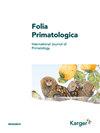Local farmers’ attitudes towards artificial wildlife bridges in a fragmented agroforestry environment
IF 0.8
4区 生物学
Q2 ZOOLOGY
引用次数: 2
Abstract
Fragmentation of tropical forests has severe consequences for global biodiversity. The island of Java, Indonesia has a long history of deforestation and outside the protected area system, the island contains a patchwork of small forest fragments among expanding agricultural land, human settlements, and infrastructure. The arboreal Javan slow loris’ (Nycticebus javanicus) remaining habitat largely occurs in these anthropogenic landscapes. Arboreal canopy bridges have proven to be a successful conservation intervention for Javan slow lorises but must be built on the private land of farmers. Here, we describe the process of collaborating with local farmers to construct and maintain canopy bridges over their farms to aid in connecting habitat for Javan slow lorises. We held non-structured conversations with ten farmers to understand their perceptions of the bridges. We found an overall positive attitude towards slow lorises, as well as acknowledgement of the economic importance of the bridges. Farmers also recommended improvements, including ensuring equity of the bridges in the community and increased financial commitment from the conservation project. There is growing appreciation amongst conservationists that trust and collaboration with local communities are essential for carrying out successful initiatives. We recommend regular discussions with community members in similar interventions to ensure the long-term trust and involvement of local people.在一个支离破碎的农林业环境中,当地农民对人工野生动物桥的态度
热带森林的破碎化对全球生物多样性产生了严重后果。印度尼西亚爪哇岛有着悠久的森林砍伐历史,在保护区系统之外,该岛包含了不断扩大的农业用地、人类住区和基础设施中的小森林碎片。树栖爪哇懒猴(Nycticebus javanicus)的剩余栖息地主要出现在这些人为景观中。事实证明,乔木雨棚桥是爪哇懒猴的一种成功的保护干预措施,但必须在农民的私人土地上建造。在这里,我们描述了与当地农民合作,在他们的农场上建造和维护遮篷桥的过程,以帮助连接爪哇懒猴的栖息地。我们与十位农民进行了非结构化的对话,以了解他们对桥梁的看法。我们发现人们对懒猴总体上持积极态度,并承认桥梁的经济重要性。农民们还建议进行改进,包括确保社区桥梁的公平性,并增加保护项目的财政承诺。自然资源保护主义者越来越认识到,与当地社区的信任和合作对于成功实施这些举措至关重要。我们建议在类似干预措施中与社区成员定期讨论,以确保当地人民的长期信任和参与。
本文章由计算机程序翻译,如有差异,请以英文原文为准。
求助全文
约1分钟内获得全文
求助全文
来源期刊

Folia Primatologica
生物-动物学
CiteScore
3.30
自引率
10.50%
发文量
36
审稿时长
>12 weeks
期刊介绍:
Recognizing that research in human biology must be founded on a comparative knowledge of our closest relatives, this journal is the natural scientist''s ideal means of access to the best of current primate research. ''Folia Primatologica'' covers fields as diverse as molecular biology and social behaviour, and features articles on ecology, conservation, palaeontology, systematics and functional anatomy. In-depth articles and invited reviews are contributed by the world’s leading primatologists. In addition, special issues provide rapid peer-reviewed publication of conference proceedings. ''Folia Primatologica'' is one of the top-rated primatology publications and is acknowledged worldwide as a high-impact core journal for primatologists, zoologists and anthropologists.
 求助内容:
求助内容: 应助结果提醒方式:
应助结果提醒方式:


